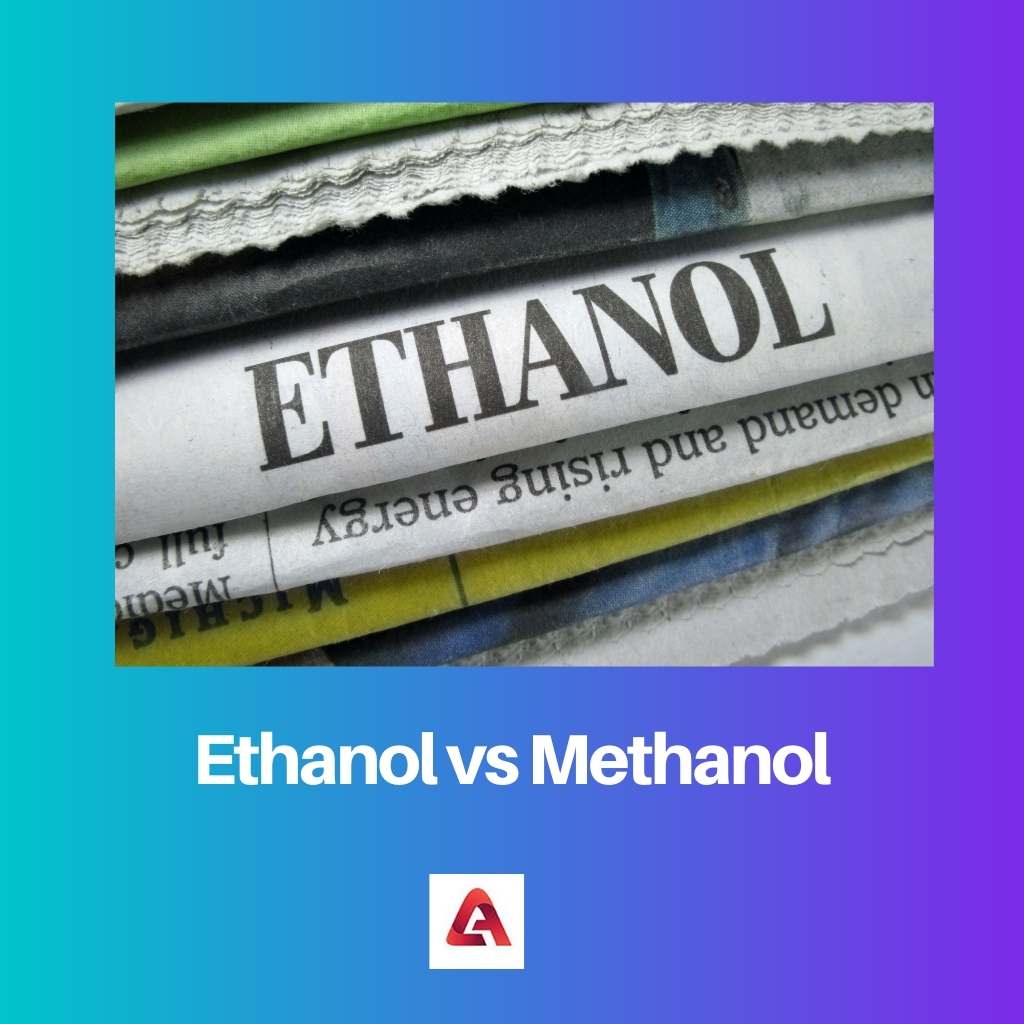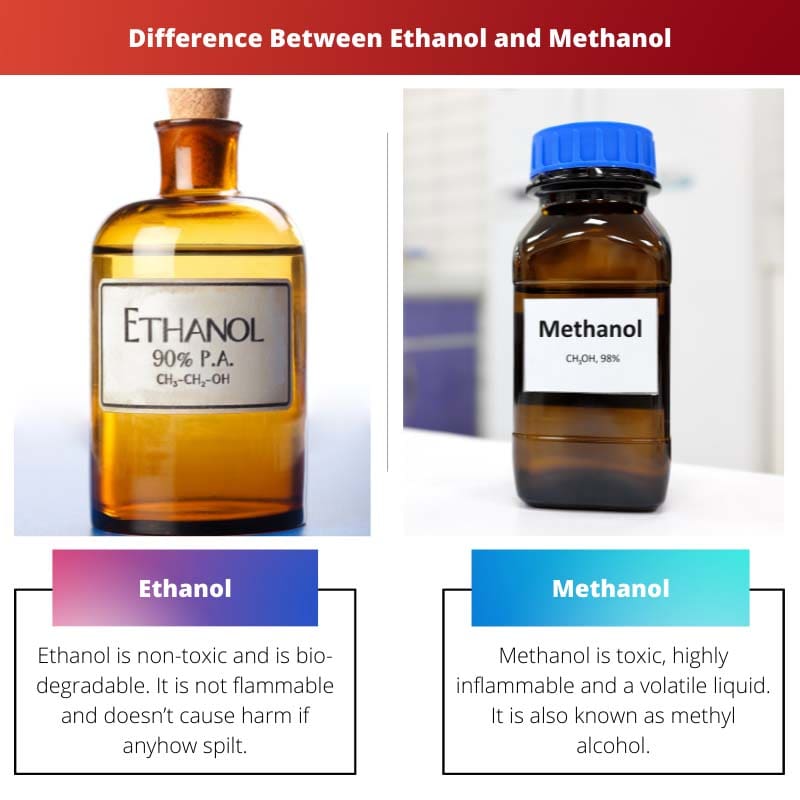Alcohols are one of the most common organic compounds. Groups of any of the organic compounds are categorised by one hydroxyl group or more (―OH) that is attached to the carbon atom of an alkyl group.
Alcohols are of many types, but the two major types of alcohol are ethanol and methanol.
Key Takeaways
- Ethanol is a renewable fuel derived from plants, while methanol is produced from natural gas or coal.
- Ethanol is less toxic and can be consumed in alcoholic beverages, whereas methanol is highly toxic.
- Methanol has a wider range of industrial applications, such as formaldehyde and antifreeze production.
Ethanol vs Methanol
Ethanol, also known as ethyl alcohol, is a clear, colorless, and flammable liquid that is commonly used as a solvent, fuel, and alcoholic beverage. Methanol, also known as wood alcohol, is a colorless, toxic, and flammable liquid that is primarily used as an industrial solvent and fuel.

Ethanol is non-toxic and bio-degradable. It is not flammable and doesn’t cause harm if spilt anyhow.
Ethanol’s chemical formula is written as C₂H₅OH.
Ethanol is a clear, colourless liquid with a pungent taste and a vinous odour. Ethanol in its primary state is Ethane, and when one of the hydroxy groups is substituted, ethanol is formed.
While methanol is toxic, highly inflammable and a volatile liquid, it is also known as methyl alcohol, and its chemical formula is CH₃OH.
Methanol is a colourless liquid with a faint, sweetly pungent-like smell. Methanol is the simplest aliphatic alcohol in the primary state, which comprises methyl with an alcohol group.
Comparison Table
| Parameters of Comparison | Ethanol | Methanol |
|---|---|---|
| Skeleton structure | Ethyl group with two carbon atoms | Ethyl group with one carbon atom |
| Toxicity | Affects the central nervous system and can cause sleepiness when ingested or consumed. | Affects the retina of the eye and can cause terminal blindness; to the extreme can also cause death if ingested mistakenly. |
| Flame | Bright blue flame when light up | Bright yellowish-white flame when light up |
| Production process | By the fermentation of yeast or sugar | By synthetically catalysing carbon di-oxide, carbon mono-oxide & hydrogen |
| Physical Properties | Colourless, volatile but not inflammable in nature | Colourless, highly volatile and & inflammable in nature |
What is Ethanol?
Ethanol was initially used as a powerful engine in the years 1826 and 1876. Ethanol was also used as a lighting fuel.
The ethanol was blended with gasoline to be used as an octane booster which occurred in the period 1920s to 1930s, and the scarcity of fuel caused demand during World War II. Petroleum-based fuel had reached heights and became expensive in the 1970s, and this further became a threat to the environment as it used leaded gasoline, which developed a need for octane and, hence the first Ethanol industry was established in that decade.
The effects and impacts of ethanol on the brain are complex, as it can cross and penetrate biological membranes and can interact and mix with multiple molecular targets of the body. The main mechanism and function that gets implicated by the effects of ethanol is the fluctuation in the levels of GABA (gamma-Aminobutyric acid) function as the levels vitalize through the receptors of GABA.
Acute ethanol acts as a barrier of glutamate neurotransmission in various parts of the brain, such as the cerebellum, NAC, hippocampus, VTA, cerebral cortex, and amygdala, in a manner which is dependent on concentration. Ethanol or ethyl alcohol is used in many personal care & cosmetic products, household products, fuels and the food industry.
Alcoholic beverages like wine, beer and liquor are made from ethanol, making them edible alcohol. Cosmetic products like lotions, creams, adhesives, and perfumes are also made from ethanol.
A lot of household products like paints, lacquers and varnish use ethanol. The food industry uses ethanol as a food preservative.
What is Methanol?
Methanol was first discovered by the Egyptians right from ancient times. They were used to utilize methanol in their embalming process of the dead bodies, which was obtained from the process of pyrolysis of wood.
Irish chemist – Robert Boyle was the first to isolate pure methanol in the year 1661 and named it as a “spirit of box”. The name was so as the chemist produced it by the process of distillation of boxwood.
The term “methyl” derivation was back in 1840 through the process called back-formation from methylene. This led to the substance gaining popularity and importance as the name called “methyl alcohol”.
Methanol can be converted to formaldehyde, which further helps in the production of items such as paints, plastics, explosives, plywood, and textiles which are permanent-pressed. Methanol was used extensively used as a fuel during World War 2.
Metabolism of methanol produces Formic acid. The body burden of formate present in methanol poisoning is high enough and can cause acidosis and several clinical symptoms.
Methanol is polar in nature as it has the presence of the hydroxyl group on the methanol structure. Methanol has a similar odour to that of ethanol and, upon inhalation or ingestion, can lead to death or can be fatal, as it can cause damage to the retina of the eye, which can even lead to terminal blindness.
If the fumes of Methanol are inhaled, it may lead to severe coughing or headache. Due to the metabolic products it forms when it is acted upon by biological enzymes such as alcohol dehydrogenase and aldehyde dehydrogenase, it can make methanol toxic and hazardous.
Methanol has been widely used as a fuel since ancient times. Due to the polar nature of methanol, it is used in various laboratories.
A lot of cooking appliances, such as stove-based appliances, use methanol as the energy fuel for working. Methanol is used in several industries for producing acetic acid, formaldehyde, butyl ethers, hydrocarbons and many other polymers for commercial usage.
Specific processes produce aromatic compounds and many hydrocarbons, such as gasoline and olefins, from methanol.
Main Differences Between Ethanol and Methanol
- Ethanol or ethyl alcohol is pure alcohol that is used as an alcoholic beverage and can be ingested or consumed, whereas Methanol or methyl alcohol cannot be ingested as it is toxic.
- When ethanol is light on fire, its flame is blue, whereas when methanol is light on fire, its flame is yellow.
- Ethanol is also referred to as “grain alcohol” or ethyl alcohol, while methanol is also called methyl alcohol.
- Ethanol is a very poor acid in comparison to water, whereas methanol is more acidic than water.
- During the iodoform test, ethanol is warmed with iodine in the presence of NaOH, and it produces a yellow-coloured precipitate, whereas when methanol is warmed with iodine in the presence of NaOH, it does not react positively.




